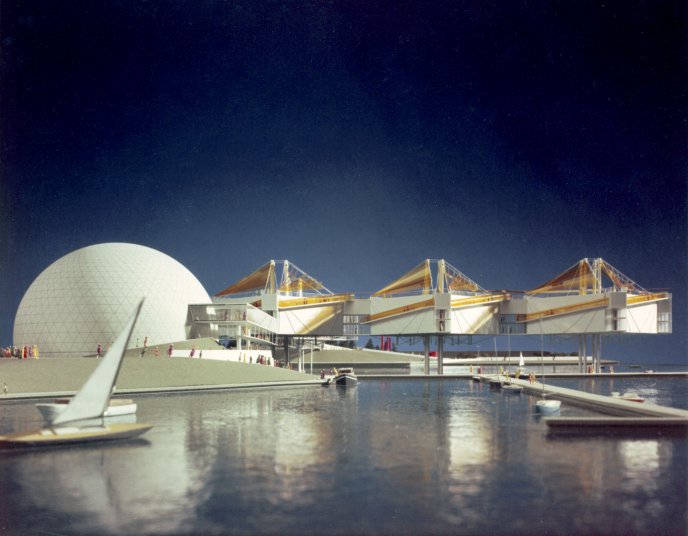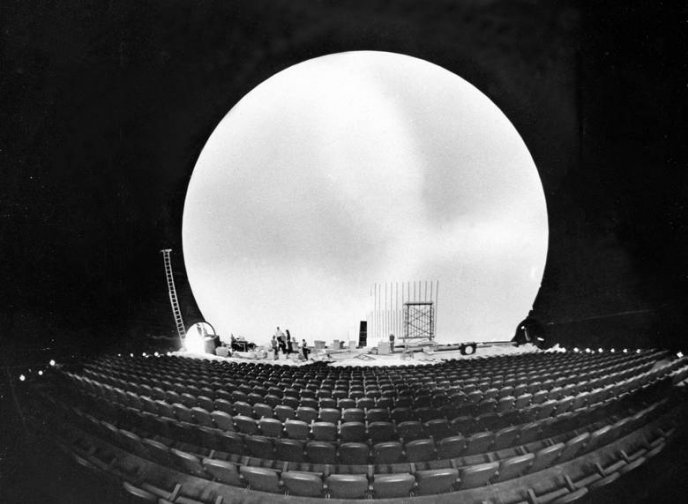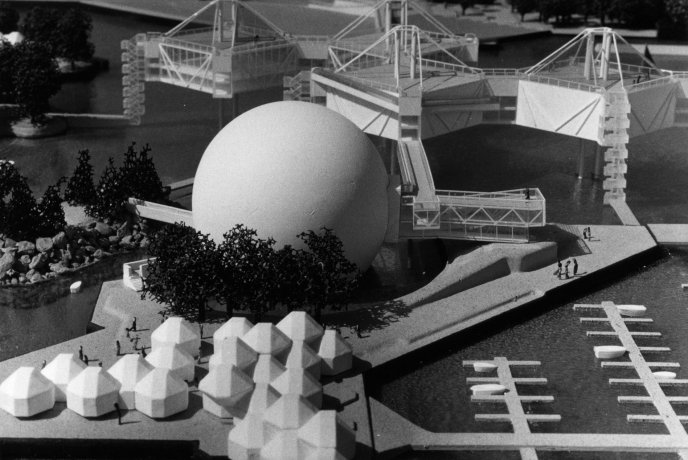Location: Toronto
Date of Completion: 1969–71
Architect: Craig, Zeidler & Strong
Date of Rehabilitation: 2011
Architect of Rehabilitation: Gow Hastings Architects Inc.
Nominated by: Chris Glover, MPP (Spadina—Fort York)
“Ontario Place is a mirror to show you yourself. Your heritage. Your land. Your work. Your creativity. And your tomorrow.”
Ontario Place promotional brochure, 1969
Boldly hovering over the lake, Ontario Place stands as a testament to the ambitions, dreams and determination of a province not afraid of big ideas, taking its place in history not only as an international architectural landmark, but also as an important cultural asset for Ontario.
 Image Credit: Courtesy of Zeidler Architecture Inc.
Image Credit: Courtesy of Zeidler Architecture Inc.
An International Landmark
Within architectural history, Ontario Place belongs to a very select group of remarkable Canadian buildings that commanded admiration and interest from across the world. These buildings, realized in tangible physical form, are some of the most ambitious utopian architectural ideas of their time, earning their place in architectural history books around the globe.
Ontario Place is unique in that it is an excellent example of not just one, but two important international design tendencies of its time: megastructures and high-tech. Megastructures envisioned ambitious and vast buildings that could function as cities—such as the utopic (and never built) proposal for Tokyo Bay where a series of large structures would allow the city to expand over the water. Meanwhile, high-tech was the name given to an approach in design where buildings were not only technologically sophisticated, but their design also reflected the technology that made them possible—such as the renowned Pompidou Centre in Paris.
With its expressive structure and its modular and replicable pods, Ontario Place is a skillfully executed example of these international tendencies and a testament to the ambitious province that was not afraid of big ideas.


Image Credit: Courtesy of Zeidler Architecture Inc.
Ontario Place was also a pioneer in film technology; its triodetic-dome structure known as the Cinesphere is home to the first permanent Imax movie theatre in the world with a custom-designed curved screen. The first film featured at Cinesphere was the award-winning, North of Superior, produced for Ontario Place by Imax founder and filmmaker Graeme Ferguson.

Image Credit: Courtesy of Zeidler Architecture Inc.
A Place for Innovation
Innovation was at the heart of Ontario Place’s unique design. While the pods and the Cinesphere might be its most salient features, key to the project’s success is the innovative 90 acres of manmade lagoons and islands with landscapes designed by noted landscape architect Michael Hough and born out of a pragmatic necessity.
Along with a quarter-mile breakwater formed by sinking three Great Lakes freighters, the islands protect the pods’ foundation pylons from the powerful waves of Lake Ontario. Above the water, the islands were envisioned as a large public realm to reconnect Ontarians to the lake—a second shoreline for Toronto, with parks, restaurants, shops and an innovative amusement area for children to animate the spaces. Ontario Place would become a precedent for waterfront redevelopment not only in the province, but also around the globe.
 Image Credit: Courtesy of Zeidler Architecture Inc.
Image Credit: Courtesy of Zeidler Architecture Inc.
In addition to the islands, pods and Cinesphere, Ontario Place was also home to other innovative structures and spaces, including The Forum, a sheltered open-air theatre built with novel glulam construction and featuring a rotating stage, and The Children’s Village, designed by Eric McMillan, which introduced groundbreaking ideas like the ball pit, net climb, punch-bag forest, birdie glide, roller slide, cave crawl, and a whole range of other interactive play elements.
Today, both the Forum and The Children’s Village have been demolished, severely affecting the vitality and design intent of Ontario Place as an active and diverse urban parkland for all. The loss of these highly celebrated and world-renowned spaces emphasize the importance of conserving the key features that remain of Ontario Place.

Image Credit: Courtesy of Zeidler Architecture Inc.
This post forms part of our World Architecture Day Queen’s Park Picks 2019 series in which we asked Ontario’s Members of Provincial Parliament to nominate a prominent building, past or present, in their riding for a chance to learn more about it. Check out the rest of the series to learn more about great buildings across the province!